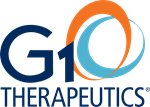- Analyses of Data from the Randomized Phase 2 Metastatic Triple Negative Breast Cancer (mTNBC) Trial Indicate That Prior Use of Trilaciclib with Cytotoxic Chemotherapy is Highly Correlated to Improved Long-Term Survival with Subsequent Anticancer Therapies -
- Improved Long-Term Survival Also Observed in Patients Who Received Prior Trilaciclib with Cytotoxic Therapy and Were Unable to Receive Subsequent Anticancer Therapy -
- Data Presented at the 2023 San Antonio Breast Cancer Symposium (SABCS) -
RESEARCH TRIANGLE PARK, N.C., Dec. 05, 2023 (GLOBE NEWSWIRE) -- G1 Therapeutics, Inc. (Nasdaq: GTHX), a commercial-stage oncology company, today announced the presentation of new data describing the long-term positive survival impact of previous treatment with trilaciclib and cytotoxic chemotherapy (gemcitabine/carboplatin; GCb) in patients with metastatic triple negative breast cancer (mTNBC) who participated in G1’s Phase 2 trial (NCT02978716). The poster is being presented at the 2023 San Antonio Breast Cancer Symposium (SABCS), held December 5th to 9th in San Antonio, TX, and is available on the G1 Therapeutics website here.
The poster entitled, “Patients with Metastatic Triple-Negative Breast Cancer Who Receive Trilaciclib Prior to Cytotoxic Chemotherapy Exhibit Improved Survival After Receiving Subsequent Anticancer Therapy” describes a post hoc analysis of data from G1 Therapeutics’ randomized Phase 2 mTNBC trial (NCT02978716; completed February 2020) indicating that patients with mTNBC who received trilaciclib with their cytotoxic chemotherapy during the trial and then received subsequent anticancer therapy (SACT) after trilaciclib discontinuation exhibit statistically significant and clinically meaningful improvements in median overall survival (OS) (32.7 months versus 12.8 months; p=0.001) and in median OS from start of first SACT (14.0 months versus 5.8 months; p=0.001) compared to those who received cytotoxic chemotherapy without trilaciclib and then received SACT. Administering trilaciclib with cytotoxic chemotherapy also led to improved survival in patients unable to receive SACT.
“These new analyses indicate that trilaciclib can protect the bone marrow and immune system against the harmful effects of cytotoxic therapy, leading to significantly improved survival outcomes among patients who receive subsequent anticancer therapies,” said Raj Malik, M.D., Chief Medical Officer at G1 Therapeutics. “The findings are particularly relevant as we are evaluating the impact of trilaciclib on long-term endpoints including overall survival in PRESERVE 2, our ongoing pivotal Phase 3 mTNBC trial, with the interim overall survival analysis expected in the first quarter of 2024.”
The Phase 2 trial (NCT02978716) enrolled patients who had received up to two prior chemotherapy regimens for locally recurrent or mTNBC. Participants were randomized into three groups: GCb alone on days 1 and 8 (n=34), trilaciclib prior to GCb on days 1 and 8 (n=33), or trilaciclib alone on days 1 and 8 and prior to GCb on days 2 and 9 (n=35). G1 conducted a post hoc survival analysis on data from patients in this Phase 2 TNBC trial who received additional anticancer therapies after discontinuation of study treatment with GCb with or without trilaciclib, to evaluate improvements in long-term outcomes; the two trilaciclib groups were combined for this analysis. The SACTs administered include gemcitabine, capecitabine, eribulin, taxane, carboplatin, and PD-1/PD-L1 inhibitors. Additionally, murine cancer models were utilized to quantify the infiltration of central memory T cells in the tumor microenvironment seven days after a single dose or seven daily doses of trilaciclib. Memory T cell recall responses (the ability of memory T cells to react rapidly on encounter with the same antigen after remission) were also evaluated.
Survival Outcomes
- After a median follow-up of 12.7 months on study, deaths were observed in 22/43 patients in the trilaciclib plus GCb group and 17/20 patients in the GCb-only group (no trilaciclib). Median time on treatment was 5.5 months in the trilaciclib plus GCb group and 3.3 months in the GCb-only group.
- Patients receiving SACT following trilaciclib plus GCb exhibited statistically significant (p=0.001) improvements in median (95% CI) OS (32.7 months; 15.3 – not estimable) compared to those receiving SACT following GCb alone (12.8 months; 8.3 – 17.8), with increasing separation of survival curves over time.
- Median OS and progression-free survival (PFS) were higher in the prior trilaciclib plus GCb group compared with the prior GCb-only group, regardless of the type of SACT received.
- Improved survival and sustained separation of curves were also observed in patients unable to receive SACT (trilaciclib, n = 25; placebo, n = 14), although the magnitude of benefit was smaller (median 9.4 vs 5.4 months).
- Patients receiving SACT following trilaciclib plus GCb also exhibited statistically significant (p=0.001) improvements in median (95% CI) OS from start of the first SACT (14.0 months; 9.0 – not estimable) compared to those receiving SACT following GCb alone (5.8 months; 4.8 – 7.2).
Immune Surveillance Results
In addition, data from murine models indicate that trilaciclib-mediated transient cyclin-dependent kinase (CDK)4/6 inhibition may enhance tumor infiltration of CD8+ central memory T cells and boost memory T cell recall responses, further clarifying the mechanism by which trilaciclib improves long-term immune surveillance:
- Compared with daily dosing, a single dose of trilaciclib resulted in an increase in the number of tumor infiltrating CD8+ central memory T cells in the tumor microenvironment on day seven.
- Administering trilaciclib enhanced the efficacy of combination immunotherapy with α-PD-1 plus α-LAG3; seven of eight mice that received trilaciclib plus α-PD-1 and α-LAG3 survived (achieved a complete response) compared to three of eight mice that received treatment with α-PD-1 plus α-LAG3.
- Following rechallenge in the opposite flank of the surviving mice, tumors implanted in those previously treated with trilaciclib grew to a smaller volume and regressed faster than controls, demonstrating the ability of trilaciclib to strengthen memory T cell recall responses.
Data generated across multiple preclinical and clinical studies to date indicate that trilaciclib has the greatest effect on longer term endpoints including OS rather than earlier efficacy measures. These new results contribute to the body of evidence suggesting that preserving bone marrow and immune system function during cytotoxic therapy and enhancing anti-tumor immunity and long-term immune surveillance by increasing the generation of certain memory T cells can allow patients to benefit while receiving trilaciclib, and after trilaciclib discontinuation when receiving SACT.
About Triple Negative Breast Cancer (TNBC)
According to the American Cancer Society, nearly 300,000 new cases of invasive breast cancer are diagnosed annually in the U.S. Triple-negative breast cancer makes up approximately 15-20% of such diagnosed breast cancers. TNBC is cancer that tests negative for estrogen receptors, progesterone receptors, and excess HER2 protein. Because mTNBC cells lack key growth-signaling receptors, patients do not respond well to medications that block estrogen, progesterone, or HER2 receptors. Instead, treating mTNBC typically involves chemotherapy, radiation, and surgery. TNBC is considered to be more aggressive and have a poorer prognosis than other types of breast cancer. In general, survival rates tend to be lower with mTNBC compared to other forms of breast cancer, and mTNBC is also more likely than some other types of breast cancer to return after it has been treated, especially in the first few years after treatment. It also tends to be higher grade than other types of breast cancer.
About G1 Therapeutics
G1 Therapeutics, Inc. is a commercial-stage oncology biopharmaceutical company whose mission is to develop and deliver next-generation therapies that improve the lives of those affected by cancer, including the Company’s first commercial product, COSELA® (trilaciclib). The Company is also evaluating therapies in combination with cytotoxic therapies and/or immunotherapy in areas of high unmet need including triple-negative breast cancer and extensive stage small cell lung cancer. G1’s goal is to provide innovative therapeutic advances for people living with cancer. G1 is based in Research Triangle Park, N.C. For additional information, please visit http://www.g1therapeutics.com and follow us on X (formerly known as Twitter) @G1Therapeutics and LinkedIn.
G1 Therapeutics® and the G1 Therapeutics logo and COSELA® and the COSELA logo are trademarks of G1 Therapeutics, Inc.
Forward-Looking Statements
This press release contains forward-looking statements within the meaning of the Private Securities Litigation Reform Act of 1995. Words such as "may," "will," "expect," "plan," "anticipate," "estimate," "intend" and similar expressions (as well as other words or expressions referencing future events, conditions or circumstances) are intended to identify forward-looking statements. Forward-looking statements in this press release include, but are not limited to, the ability of trilaciclib to protect the bone marrow and immune system against the harmful effects of cytotoxic therapy, leading to significantly improved survival outcomes among patients who receive subsequent anticancer therapies and that preservation of the lymphoid lineage and expanded memory T cell pool are critical for long-term immune surveillance and eliciting rapid recall responses, are based on the company’s expectations and assumptions as of the date of this press release. Each of these forward-looking statements involves risks and uncertainties. Factors that may cause the company’s actual results to differ from those expressed or implied in the forward-looking statements in this press release are discussed in the company’s filings with the U.S. Securities and Exchange Commission, including the "Risk Factors" sections contained therein and include, but are not limited to, the company’s dependence on the commercial success of COSELA (trilaciclib); the development and commercialization of new drug products is highly competitive; the company’s ability to complete clinical trials for, obtain approvals for and commercialize any of its product candidates; the company’s initial success in ongoing clinical trials may not be indicative of results obtained when these trials are completed or in later stage trials; the inherent uncertainties associated with developing new products or technologies and operating as a commercial-stage company; and market conditions. Except as required by law, the company assumes no obligation to update any forward-looking statements contained herein to reflect any change in expectations, even as new information becomes available.
G1 Therapeutics Contacts:
Will Roberts
Vice President, Investor Relations & Corporate Communications
919-907-1944
wroberts@g1therapeutics.com







